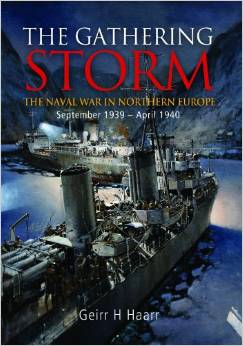The Gathering Storm: The Naval War in Northern Europe, September 1939-April 1940
Geirr H. Haarr
 Haar’s book covers the initial naval conflict in the European theater of World War Two. The writing covers important developments prior to the outbreak of hostilities in September 1939. Events relating to submarine, merchant marine, surface navy, and naval aviation are described. The author presents Allied, Axis, and neutral actions during the period. Geographically, attention focuses on the Baltic and North seas. Some global events and expeditions are covered as they relate to events under discussion.
Haar’s book covers the initial naval conflict in the European theater of World War Two. The writing covers important developments prior to the outbreak of hostilities in September 1939. Events relating to submarine, merchant marine, surface navy, and naval aviation are described. The author presents Allied, Axis, and neutral actions during the period. Geographically, attention focuses on the Baltic and North seas. Some global events and expeditions are covered as they relate to events under discussion.
Several key themes are contained within this book. Contrary to popular opinion, Haar presents the opening months of the war as anything but a ‘phony war.’ The British Royal Navy’s experience is described as a painful rebirth. Finally, the image of Germany’s Kriegsmarine is constantly presented as efficient, if still imperfect.
Detailed descriptions of important events in the opening months of World War Two help debunk the image of a ‘phony war’ during this time. Extreme detail is provided for the most important occurrences, like the Altmark incident. A great level of detail is provided for more general developments as well. Diaries, war records, correspondence, official reports, and radio logs all help paint an intricate picture of a very active theater of war. As mentioned in Haar’s work, hostilities commenced within hours of war being declared and continued virtually unabated for the entire period under consideration.
The British Royal Navy experienced a painful and difficult rebirth in the opening months of the Second World War. The Admiralty failed to adjust to new developments like advanced submarines and naval aviation. Warnings about German aggression were not heeded and a rapid mobilization of reserve naval forces took time the British could ill afford to waste. Adjusting to advanced submarine tactics cost the British dearly. Many merchantmen and several warships, including the aircraft carrier Courageous and the battleship Royal Oak, were lost. Increased defenses against aggressive German U-Boat tactics could have prevented this. British submarine actions and naval intelligence left a great deal to be desired. Hard earned lessons were rapidly taken to heart, however, and the British soon worked hard to regain naval supremacy in Northern Europe.
Germany’s Kriegsmarine was well prepared for war with disciplined and well trained crews and officers. Personnel were proficient and familiar with modern technologies, tactics, and strategies. However, inadequate testing of German naval technologies, most notably submarine torpedoes, resulted in several missed opportunities to further cripple British naval might early in the war. Adolf Hitler’s policy of restricted submarine warfare at the outset of war, however, limited offensive capabilities. If this policy had been lifted, Germany could have crippled British naval might early in the war.
Haar presents a balanced and well researched picture of the opening months of the naval conflict during World War Two. He presents convincing arguments without bias. A vast collection of photographs and other archival material help complete the image Haar creates. Information in the appendices is thoroughly researched and supports Haar’s arguments. All though a great deal of detail is presented, Haar does not lose site of the larger argument and constantly references back to his key arguments.
- Annapolis: Naval Institute Press, 2013
- 6-1/4” x 9-1/2”, hardcover, x + 550 pages
- Photographs, maps, notes, bibliography, index. $52.95
- ISBN: 9781591143314
Reviewed by Ivor R. Mollema, East Carolina University
